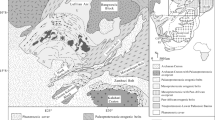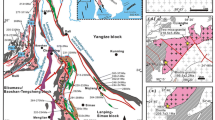Abstract
The development of rapakivi texture in feldspars from the Ketilidian granitoids of south Greenland has been investigated using Sr, O and H isotopes. A low temperature signature is found in the Sr and O data which seemingly contradicts some textural features that point to a magmatic origin of the plagioclase mantles around the K-feldspar ovoids. An origin for these mantles involving exsolution from an original alkali feldspar solid solution is proposed, which involves growth of mantles over a range of conditions determined by the mobility of the exsolving sodic feldspar. This mobility may be enhanced at high temperatures in the presence of melts or increased fluid pressures and at lower temperatures by the processes responsible for the transformation of K-feldspar to microcline. Rapakivi granites with both white and dark green feldspar occur in south Greenland but show no major isotopic differences, although the dark alkali feldspars contain significantly more fluid. Equivalent fluids in the white alkali feldspars may have escaped during plagioclase exsolution.
Similar content being viewed by others
References
Abbott RN Jr (1978) Peritectic reactions in the system An−Ab−Or−Qz−H2O. Can Mineral 16:245–256
Allaart JH (1976) Ketilidian mobile belt in South Greenland. In: Escher A, Watt WS (eds) Geology of Greenland. Gronland Geol Unders. Copenhagen, pp 121–151
Bachinski SW, Mueller G (1971) Experimental determinations of the microcline-low albite solvus. J Petrol 12:329–356
Borthwick J, Harmon RS (1982) A note regarding CIF3 as an alternative to BrF5 for oxygen isotope analysis. Geochim Cosmochim Acta 46:1665–1668
Bottinga Y, Javoy M (1975) Oxygen isotope partitioning among minerals in igneous and metamorphic rocks. Rev Geophys Space Phys 13:401–418
Brigham RII, O'Neil JR (1985) Genesis and evolution of water in a two-mica pluton: a hydrogen isotope study. Chem Geol 49:159–177
Brown WL, Becker SM, Parsons I (1983) Cryptoperthites and cooling rate in a layered syenite pluton: A chemical and TEM study. Contrib Mineral Petrol 82:13–25
Brown WL, Parsons I (1989) Alkali feldspars: ordering rates, phase transformations and behaviour diagrams for igneous rocks. Mineral Mag 53:25–42
Buddington AF, Lindsley DH (1964) Iron-titanium oxide minerals and synthetic equivalents. J Petrol 5:310–357
Clayton RN, Mayeda TK (1963) The use of bromine pentafluoride in the extrraction of oxygen from oxides and silicates for isotopic analysis. Geochim Cosmochim Acta 27:43–52
Dawes PR (1966) Genesis of rapakivi. Nature 209:569–571
Dempster TJ (1986) Isotope systematics in minerals: biotite rejuvenation and exchange during Alpine metamorphism. Earth Planet Sci Lett 78:355–367
Elliston JN (1985) Rapakivi texture: an indication of the crystallization of hydrosilicates, 2. Earth Sci Rev 22:1–92
Elphick SC, Graham CM, Dennis PF (1988) An ion microprobe study of anhydrous oxygen diffusion in anorthite: a comparison with hydrothermal data and some geological implications. Contrib Mineral Petrol 100:490–495
Farver JR, Giletti BJ (1989) Oxygen and strontium diffusion kinetics in apatite and potential application to thermal history determinations. Geochim Cosmochim Acta 53:1621–1631
Friedman I, Smith RL (1958) The deuterium content of water in volcanic glass. Geochim Cosmochim Acta 15:218–228
Frost BR, Frost CD (1987) CO2 melts and granulite metamorphism. Nature 327:503–506
Geist DJ, Myers JD, Frost CD (1988) Megacryst — bulk rock disequilibrium as an indicator of contamination processes: The Edgecumbe Volcanic Field, Southeast Alaska. Contrib Mineral Petrol 99:105–112
Giletti BJ, Anderson TF (1975) Studies in diffusion — II. Oxygen in phlogopite mica. Earth Planet Sci Lett 28:225–233
Gulson BL, Krogh TE (1975) Evidence of multiple intrusion, possible resetting of U−Pb ages, and new crystallization of zircons in the post-tectonic intrusions (‘Rapakivi granites’) and gneisses from south Greenland. Geochim Cosmochim Acta 39:65–82
Halliday AN, Fallick AE, Dickin AP, Mackenzie AB, Stephens WE, Hildreth W (1983) The isotopic and chemical evolution of Mount St. Helens. Earth Planet Sci Lett 63:241–256
Harrison TN, Dempster TJ, Hutton DHW, Brown PE (1991) Low pressure granulites from the Ketilidian Mobile Belt of southern Greenland. J Petrology (submitted)
Harrison TN, Parsons I, Brown PE (1990) Fayalite-bearing rapakivi granites from the Prins Christians Sund pluton, south Greenland. Mineral Mag 54:57–64
Hawkes J (1967) Rapakivi texture in the Dartmoor Granite. Proc Usher Soc 1:270–272
Hibbard MJ (1981) The magma mixing origin of mantled feldspar. Contrib Mineral Petrol 76:158–170
Hughes CJ (1982) Igneous petrology. Elsevier, Amsterdam
Hutchinson RM (1956) Structure and petrology of Enchanted Rock batholith, Llano and Gillespie counties, Texas. Bull Geol Soc Am 67:763–806
Hutton DHW, Dempster TJ, Brown PE, Becker SM (1990) A new mechanism of granite emplacement: rapakivi intrusions in active extensional shear zones, south Greenland. Nature 343:452–454
Jäger E (1979) Introduction to geochronology. In: Jäger E, Hunziker JC (eds) Lectures in isotope geology. Springer, Berlin Heidelberg New York, pp 1–12
Kuroda Y, Yameda T, Fujimoto K, Suzuoki T, Matsuo S (1978) Hydrogen isotope study on biotite and hornblende from Finnish granitic rocks. Geochem J 12:259–263
Manning DAC, Pichavant M (1983) The role of fluorine and boron in the generation of granitic melts. In: Atherton MP, Gribble CD (eds) Migmatites, melting and metamorphism, Shiva, Nantwich, UK, pp 94–109
Matsuhisa Y, Goldsmith JR, Clayton RN (1979) Oxygen isotope fractionation in the system quartz-albite-anorthite-water. Geochim Cosmochim Acta 43:1131–1140
Morse SA (1970) Alkali feldspars with water at 5 Kb pressure. J Petrol 11:221–251
Niggli P (1923) Gesteins- und Mineralprovinzen (in German). Band 1: Einführungen Berlin
O'Neil JR (1986) Theoretical and experimental aspects of isotopic fractionation. In: Valley JW, Taylor HP Jr, O'Neil JR (eds) Stable isotopes in high temperature geological processes. Reviews in mineralogy, Min Soc Am 16:1–40
O'Neil JR, Taylor HP Jr (1967) The oxygen isotope and cation exchange chemistry of feldspars. Am Mineral 52:1414–1437
Parsons I (1978) Feldspars and fluids in cooling plutons. Mineral Mag 42:1–17
Rundkvist ND (1989) Composition and structure of alkali feldspar ovoids of rapakivi granites and succession of their formation. Geol Surv Finland Spec Paper 8:114
Savolahti A (1962) The rapakivi problem and the rules of idiomorphism in minerals. Bull Comm Geol Finland 204:15–67
Sederholm JJ (1891) Über die finnländischen Rapakiwigesteine. Tschermaks Mineral Petrol Mitt 12:1–31
Shaw HR (1963) Obsidian — H2O viscosities at 1000 and 2000 bars and in the temperature range 700–900° C. J Geophys Res 68:6337–6343
Sipling PJ, Yund RA (1976) Experimental determination of the coherent solvus for sanidine-high albite. Am Mineral 61:897–906
Smith P, Parsons I (1974) The alkali-feldspar solvus at 1 kilobar water-vapour pressure. Mineral Mag 39:747–767
Streckeisen A (1976) To each plutonic rock its proper name. Earth Sci Rev 12:1–33
Suzuoki T, Epstein S (1976) Hydrogen isotope fractionation between OH-bearing minerals and water. Geochim Cosmochim Acta 40:1229–1240
Taylor HP Jr (1974) The application of oxygen and hydrogen isotope studies to problems of hydrothermal alteration and ore deposition. Econ Geol 69:843–883
Taylor HP Jr, Sheppard SMF (1986) Igneous rocks: 1. Processes of isotopic fractionation and isotope systematics. In: Valley JW, Taylor HP Jr, O'Neil JR (eds) Stable isotopes in high temperature geological processes. Reviews in mineralogy. Min Soc Am 16:227–271
Tuttle OF, Bowen NL (1958) Origin of granite in the light of experimental studies in the system NaAlSi3O8−KAlSi3O8−SiO2−H2O. Mem Geol Soc Am 74:1–153
Van Breemen O, Aftalion M, Allaart JH (1974) Isotopic and geochronologic studies on granites from the Ketilidian Mobile Belt of south Greenland. Bull Geol Soc Am 85:403–412
Velikoslavinskiy DA (1953) Petrology of the Wiborg rapakivi massive (in Russian) Tr Labor Geol Dokembrija An SSSR, 3
Vollmer R, Johnson K, Giara MR, Lirer L, Munno R (1981) Sr isotope geochemistry of megacrysts from continental rift and convergent plate margin alkaline volcanism in south Italy. J Volcan Geotherm Res 11:314–327
Vorma A (1971) Alkali feldspars of the Wiborg rapakivi massif in southeastern Finland. Bull Comm Geol Finland 246:1–72
Vorma A (1972) On the contact aureole of the Wiborg rapakivi granite massif in southeastern Finland. Geol Surv Finland Bull 255:28 pp
Vorma A (1976) On the geochemistry of rapakivi granites with special reference to the Laitila massif, southwestern Finland. Geol Surv Finland Bull 285:1–98
Worden RH, Walker FDL, Parsons I, Brown WL (1990) Development of microporosity, diffusion channels and deuteric coarsening in perthitic alkali feldspars. Contrib Mineral Petrol 104:507–515
Yoder HS Jr, Stewart DB, Smith JR (1957) Ternary feldspars. Carnegie Inst, Washington Yearbk 56:206–214
Yund RA (1984) Alkali feldspar exsolution: kinetics and dependence on alkali interdiffusion. In: Brown WL (ed) Feldspars and feldspathoids, structures, properties and occurrences. NATO ASI series. Reidel, Dordrecht, pp 281–315
Author information
Authors and Affiliations
Rights and permissions
About this article
Cite this article
Dempster, T.J., Hutton, D.H.W., Harrison, T.N. et al. Textural evolution of the rapakivi granites, south Greenland —Sr, O and H isotopic investigations. Contr. Mineral. and Petrol. 107, 459–471 (1991). https://doi.org/10.1007/BF00310680
Received:
Accepted:
Issue Date:
DOI: https://doi.org/10.1007/BF00310680




